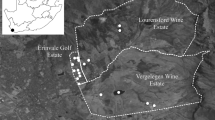Abstract
Desert stream insects may use rainfall cues to anticipate and escape flash floods, but this has been studied in few taxa. We used controlled, replicated experiments to quantify the use of rainfall cues for flood escape in seven common desert stream insects. The hemipterans Curicta pronotata and Aquarius remigis responded consistently to rainfall cues by crawling vertically away from the water, in such a way that they may escape flash floods in nature. The coleopteran Gyrinus plicifer showed no response to rainfall cues. The hemipteran Ambrysus woodburyi did not exit the water but sought refuge under submerged rocks. Three taxa (Ranatra quadridentata, Corydalus texanus, and Rhantus atricolor) gave ambiguous results, although the latter apparently responded to environmental cues other than rainfall. We conclude that rainfall cues are a sufficient mechanism for flood escape in some taxa, but other desert stream insects may employ different strategies (behavioral, life history, or morphological) to survive floods.





Similar content being viewed by others
References
Bogan MT (2005) Diversity and community structure of aquatic insects in isolated montane desert streams. M.Sc. Thesis, Oregon State University, Corvallis
Bogan MT, Lytle DA (2007) Seasonal flow variation allows ‘time-sharing’ by disparate aquatic insect communities in montane desert streams. Freshw Biol 52:290–304
Contreras-Ramos A (1998) Systematics of the dobsonfly genus Corydalus (Megaloptera: Corydalidae). Entomological Society of America, Lanham
Fisher SG, Gray LJ, Grimm NB, Busch DE (1982) Temporal succession in a desert stream ecosystem following flash flooding. Ecol Monogr 52:93–110
Frutiger A (2002) The function of the suckers of larval net-winged midges (Diptera: Blephariceridae). Freshw Biol 47:293–302
Gray LJ, Fisher SG (1981) Postflood recolonization pathways of macroinvertebrates in a lowland Sonoran Desert stream. Am Midl Nat 106:249–257
Hart DD, Finelli CM (1999) Physical-biological coupling in streams: the pervasive effects of flow on benthic organisms. Ann Rev Ecolog Syst 30:363–395
Herrmann DP, Sites RW, Willig MR (1993) Influence of current velocity on substratum selection by Naucoridae (Hemiptera): an experimental approach via stream simulation. Environ Entomol 22:571–576
Hoekstra JD, Smith RL (1998) Distribution and habitat of Curicta pronotata (Hemiptera: Nepidae) in Southeastern Arizona. Entomol News 109:366–368
Keffer SL (1996) Systematics of the New World waterscorpion genus Curicta Stål (Heteroptera: Nepidae). J N Y Entomol Soc 104:117–215
Lancaster J, Hildrew AG (1993) Flow refugia and the microdistribution of lotic invertebrates. J North Am Benthol Soc 12:385–393
Lytle DA (1999) Use of rainfall cues by Abedus herberti (Hemiptera: Belostomatidae): a mechanism for avoiding flash floods. J Insect Behav 12:1–12
Lytle DA (2000) Biotic and abiotic effects of flash flooding in a montane desert stream. Arch Hydrobiol 150:85–100
Lytle DA (2002) Flash floods and aquatic insect life history evolution: evaluation of multiple models. Ecology 83:370–385
Lytle DA (2003) Reconstructing long-term flood regimes with rainfall data: effects of flood timing on caddisfly populations. Southwest Nat 48:36–42
Lytle DA, Poff NL (2004) Adaptation to natural flow regimes. Trends Ecol Evol 19:94–100
Lytle DA, Smith RL (2004) Exaptation and flash flood escape in the giant waterbugs. J Insect Behav 17:169–178
Mahner M (1993) Systema Cryptoceratum Phylogeneticum. Zoologica 143:1–302
Molles MC Jr (1985) Recovery of a stream invertebrate community from a flash flood in Tesuque Creek, New Mexico. Southwest Nat 30:279–287
Patten DT, Harpman DA, Voita MI, Randle TJ (2001) A managed flood on the Colorado River: background, objectives, design, and implementation. Ecol Appl 11:635–643
Shafroth PB, Beauchamp VB (2006) Defining ecosystem flow requirements for the Bill Williams River, Arizona. Open File Report 2006-1314, US Geological Survey, Reston
Sites RW, Polhemus JT (1994) Nepidae (Hemiptera) of the United States and Canada. Ann Entomol Soc Am 87:27–42
Sites RW, Willig MR (1991) Microhabitat associations of three sympatric species of Naucoridae (Insecta: Hemiptera). Environ Entomol 20:127–134
Acknowledgements
M. Bogan, A. Cordova, M. Knoderbane, L. McMullen, A. Pelegrin, M. Reyes, and A. Waggener helped with field collection and behavioral experiments. A. Pelegrin provided photos of specimens, and M. Bogan helped with taxonomy. Thanks to D. Wilson and the AMNH Southwestern Research Station for providing accommodations and facilities. Insects were collected under USDA Forest Service Special Use Permit #SUP0092. This project was supported by National Science Foundation (U.S.A.) grant DEB-0445366 to DAL.
Author information
Authors and Affiliations
Corresponding author
Rights and permissions
About this article
Cite this article
Lytle, D.A., White, N.J. Rainfall Cues and Flash-Flood Escape in Desert Stream Insects. J Insect Behav 20, 413–423 (2007). https://doi.org/10.1007/s10905-007-9089-9
Published:
Issue Date:
DOI: https://doi.org/10.1007/s10905-007-9089-9




